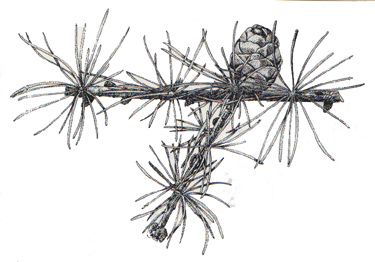
Larch
Larix laricina
(Pinaceae)

Larch
Larix laricina
(Pinaceae)
Description:
A small tree, larch grows to about 33 feet (10 meters) tall,
with brownish bark, horizontal branches, and a thin crown. The leaves, deciduous
needles, form fascicles of ten to twenty on short spur branches. The branches
are long, very narrow, slender, and flexible, three-angled and blue-green. Before
falling in early autumn they turn yellow. The twigs are long, stout, dull tan,
and hairless, with many short stout spur twigs. Winter buds are small and round,
about 1/2 inch (2 mm.) long and covered by many short, pointed, overlapping
scales. Rounded, upright female cones measure 2/5 to 3/4 inch
(1 to 1.5 cm.) long. Some of the tree's common names are Alaska larch, eastern
larch, hackamatack, and tamarack.
Distribution:
The larch is found across northern North America.
Medicinal uses:
Larch bark tea is laxative, tonic, diuretic, alterative.
It is useful in obstructions of the liver, rheumatism, jaundice, and some cutaneous
diseases. (Grieve) She also reports the use of the leaves as a decoction for
piles, haemoptysis, menorrhagia, diarrhea, and dysentery.
The inner bark, made into tea, is good for bleeding of any kind, hemorrhoids, excessive menstruation, and as a tonic to the liver and spleen. (Kloss) Tobe says to mix with spearmint, juniper, and horseradish in a bark decoction for liver and skin disorders, rheumatism, as a laxative, and externally for piles, itching, menorrhagia and dysmenorrhea.
Culinary use:
In the spring the buds can be eaten raw or cooked. They are quite sweet.
Copyright © 1987 by Eleanor G. Viereck